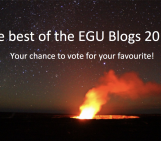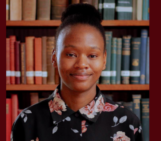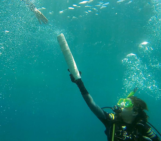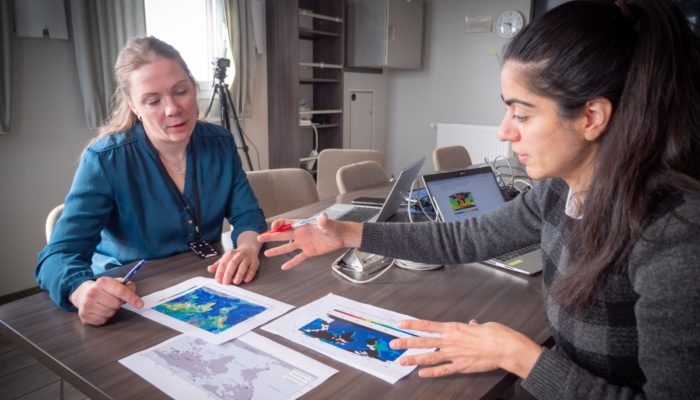
An email from Giuliana Panieri, a geology professor at the Arctic University of Norway (UiT) in Tromsø, cracked my pandemic bubble late last year. She invited me to join an unconventional expedition (AKMA OceanSenses) to the Arctic Ocean, where scientists worked hand-in-hand with other societal actors, to integrate different kinds of knowledge and create tools that help open up people’s minds to a new connection with this remote yet fragile place. I was immediately on board with the idea!
She told me there would be teachers joining, developing lesson plans for their schools. I told her about the EGU’s Teacher-Scientist Pairing Scheme. Vibeke Aune, a high school teacher at the UiT’s School Laboratory of Science and Technology, joined our discussion. Ideas merged quickly. And we got to work.
Before we look at Vibeke and Giuliana’s co-creation across the Arctic Ocean, let’s rewind to 2020 when the pairing scheme was tested for the first time. In response to the COVID-19 pandemic, the EGU’s Outreach and Education committees decided to try something new for the vEGU21 General Assembly. They connected an 11th grade (i.e., 16-17 year olds) science teacher with a scientist to co-create and teach a lesson plan online during the conference week. The lesson was streamed online from a school classroom in Algarve (Portugal) with the scientist joining virtually from the University of Lisbon. The session successfully blurred the boundaries between the scientist and the teacher as they passed the teaching torch back and forth.
This pedagogical dance is known as “teaching duet” or “paired teaching” in which teachers and scientists collaborate as equal partners, both in curriculum development and teaching.
Following its success, the Outreach and Education committees expanded the initiative to support the production of paired teaching video lessons in 2022.
Paired teaching is not a new concept
During a visit to a rural school in China, two MIT faculty members noticed how a teacher used a videotaped lecture in the classroom, pausing from time to time to engage the students. They considered the notion of interactive video lessons in which a video-scientist presents a scientific concept that is explored in the school classroom under the guidance of an in-class teacher. This idea led to MIT BLOSSOMS (Blended Learning Open Source Science or Math Studies), a repository of more than 100 freely available video lessons produced by university and high school teachers around the world. Later, in 2016, the ParsQuake team, supported by the EGU Public Engagement grant, adapted the BLOSSOMS’ approach to create geoscience video lessons. These lessons were subsequently tested in schools in the UK and Tajikistan with results published in EGU’s open access journal Geoscience Communication.
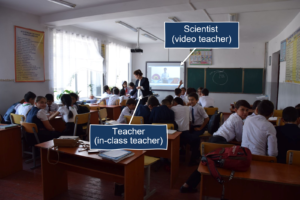
The paired teaching pedagogy. A school teacher facilitates hands-on activities introduced by a video-teacher (a guest scientist) in October 2018 at a school in Dushanbe, Tajikistan. Photo credit: Solmaz Mohadjer
Journey to a cold seep!
So what did Giuliana and Vibeke come up with while at sea in the Arctic Ocean in May 2022? They created the EGU’s first paired teaching video and called it A journey to a cold seep: how scientists study methane in the Arctic Ocean.
Vibeke wanted to bridge her classroom to the real world, showing her students how scientists use data to answer questions about the world around them. Giuliana wanted to communicate her science with non-experts including youths.
The pairing scheme was an excellent opportunity for them to brainstorm ideas and co-create a lesson plan that can be used in Vibeke’s classroom and beyond. Being on the vessel for nearly two weeks allowed them to transform their ideas into a fully fleshed out story and video lesson. I was there to facilitate this process together with Davide Oddone, our filmmaker.
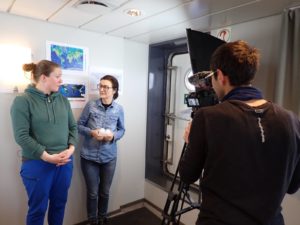
Vibeke Aune (left) and Giuliana Panieri (right) making their paired teaching video aboard the research vessel Kronprins Håkon. Photo credit: Solmaz Mohadjer
Once the expedition was over and we all had some time to reflect on the experience, I asked Giuliana and Vibeke how they felt about the whole thing. “I liked the experience very much. It is not something that you do without preparation and planning, but in the end, I was delighted,” said Giuliana. The pairing scheme also encouraged her to practice a more accessible language than the one she uses daily with her scientist colleagues. She advises scientists interested in the pairing scheme to be scientifically well-prepared, be willing to spread the knowledge to different audiences, and be motivated by the fact that their efforts may result in more young people studying science.
Vibeke also enjoyed working with scientists in developing the lesson plan: “I learned how to present science, how to help scientists present their science and how to teach science more effectively in my classroom.” Her top tip for teachers interested in participating in the pairing scheme is to find a topic that interests them and their students, and teach in a way that encourages their students to use their knowledge in new ways.
Scientists and teachers, are you interested?
EGU’s Outreach and Education committees are looking for enthusiastic scientists and teachers who would like to volunteer to co-create and teach a video lesson. Keep an eye out for the call which will be announced soon via the EGU’s website, newsletter and social media channels. Meanwhile, check out the following video lessons to get an idea of what paired teaching looks like and if it is something you’d like to try out:
- A journey to a cold seep: how scientists study methane in the Arctic Ocean and the accompanying lesson plan (EGU video)
- The physics of pool (MIT BLOSSOMS video)
- Soft Rocks and Hard Liquids: Properties of Earth Materials (ParsQuake video)
While program participants are volunteers, EGU’s team will provide guidance and support with filmmaking and editing, closed captioning and subtitles, and purchasing materials needed for the lesson plan. Your final video will be released under Creative Commons Attribution license (reuse allowed) on the EGU’s YouTube channel, and widely disseminated on social media.
Please get in touch with the Outreach Committee at outreach@egu.eu or contact Solmaz Mohadjer directly at solmaz.mohadjer@gmail.com to discuss ideas and ask questions!

